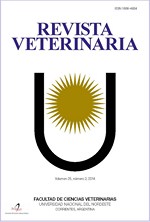Influence of irrigation type in the prevalence of bovine fasciolosis, Cajamarca-Peru
DOI:
https://doi.org/10.30972/vet.3416610Palabras clave:
Cattle, Fasciola hepática, irrigation systems, integrated control, prevalenceResumen
Fasciolosis is a relevant zoonotic disease in the Peruvian Andes, it causes considerable economic losses by reducing cattle productivity and currently, resistance to anthelmintics is reported, so it is necessary to find new ways to comprehensively control this parasitosis. In this context, the objective of this study was to demonstrate the influence of the type of irrigation on the prevalence of bovine (Bos taurus) fasciolosis in dairy production units in the province of San Marcos, Cajamarca region, Peru. A total of 20 dairy cattle were introduced in two farms with different irrigation systems: traditional or flood irrigation (n = 10) and technified or sprinkler irrigation (n = 10). Starting in March and for ten consecutive months they were fed the rations produced on the farms and the prevalence of fasciolosis was monitored using the coproparasitological technique of natural sedimentation. In the livestock unit using flood irrigation, eggs excretion began in August, with a final prevalence of 60%; while in the livestock unit using sprinkler irrigation, the first cases were detected in September and the final prevalence was 20%. To the results, Fischer’s test determined that there was no association between the prevalence of the parasite and the type of irrigation (p=0.1698). The study suggests that the prevalence of fasciolosis in cattle fed rye-grass (Lolium perenne) / clover (Trifolium repens) grown with flood irrigation was higher than that of sprinkler irrigation; however, it is recommended to investigate with a larger number of samples and use more specific diagnostic methods.Descargas
Descargas
Publicado
Cómo citar
Número
Sección
Licencia
Política de acceso abierto
Esta revista proporciona un acceso abierto inmediato a su contenido, basado en el principio de que ofrecer al público un acceso libre a las investigaciones ayuda a un mayor intercambio global de conocimiento. La publicación por parte de terceros será autorizada por Revista Veterinaria toda vez que se la reconozca debidamente y en forma explícita como lugar de publicación del original.
Esta obra está bajo una licencia de Creative Commons Reconocimiento-NoComercial 4.0 Internacional (CC BY-NC 4.0)










.jpg)
.jpg)



